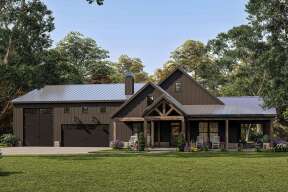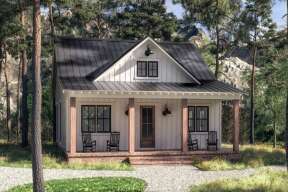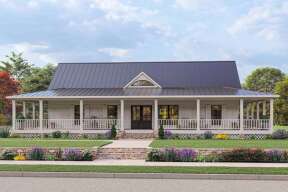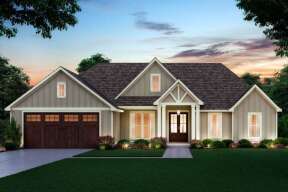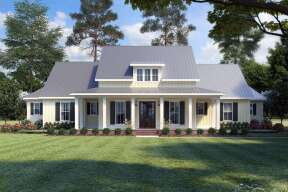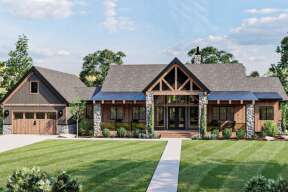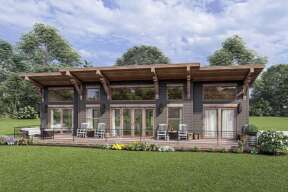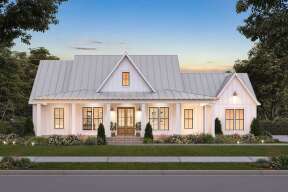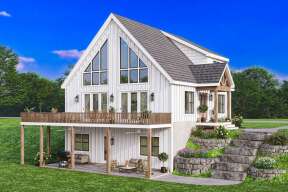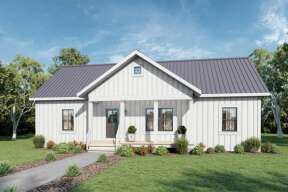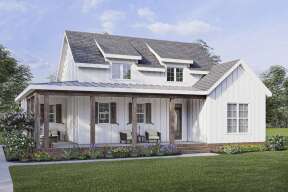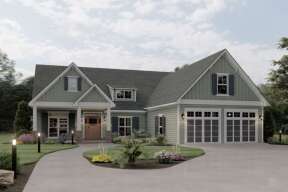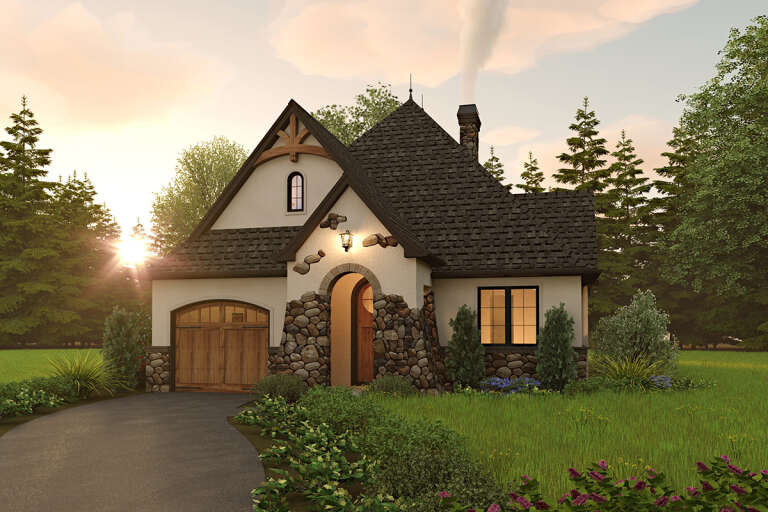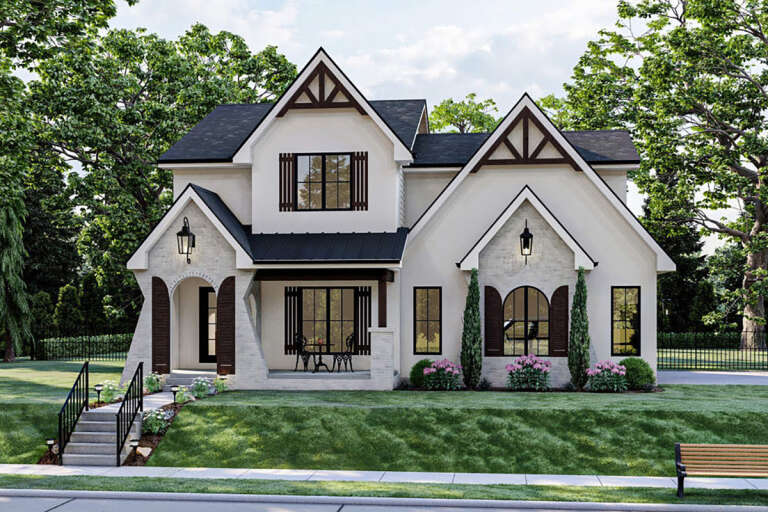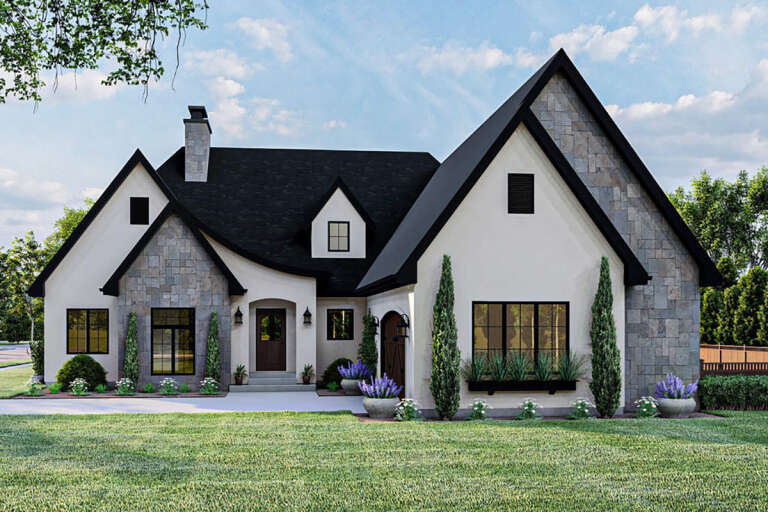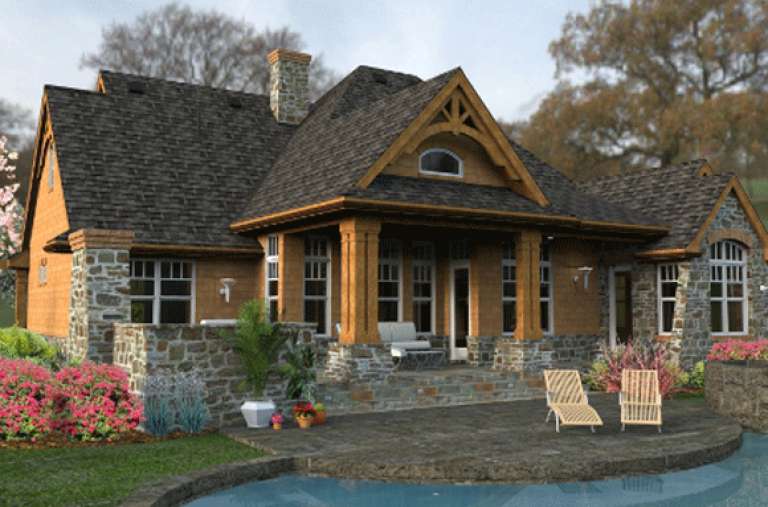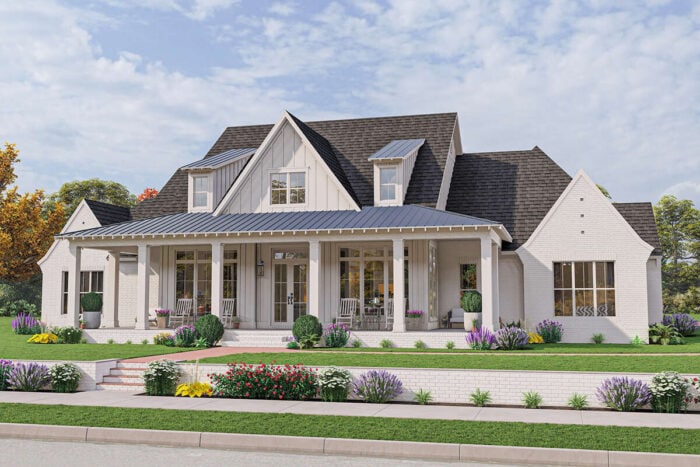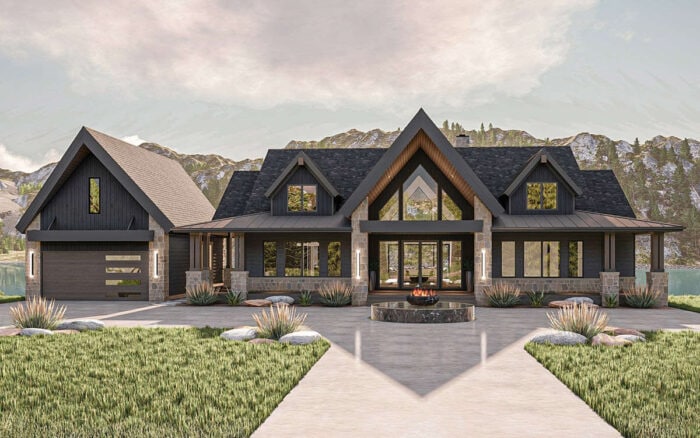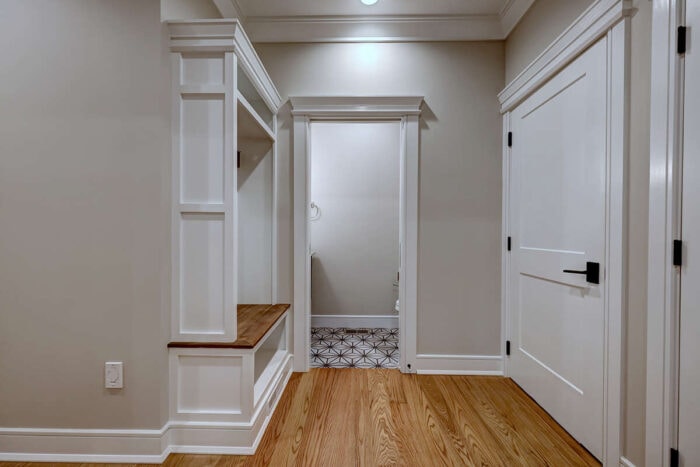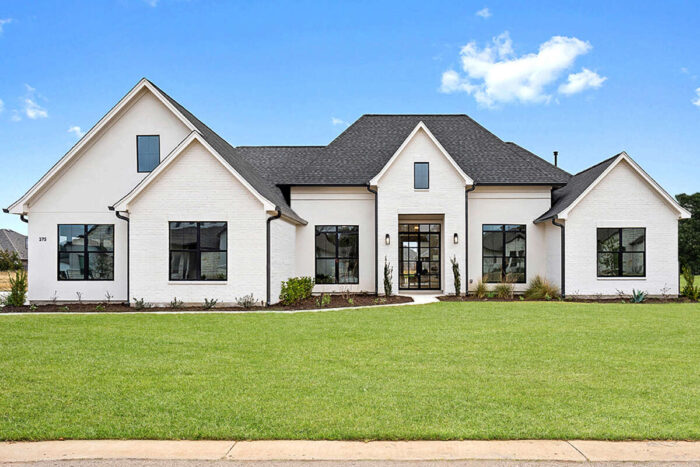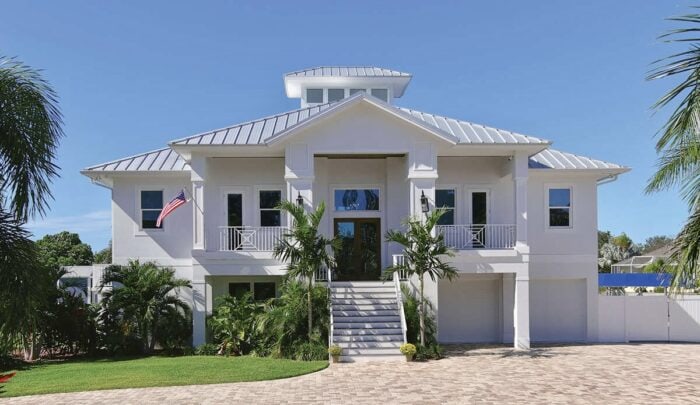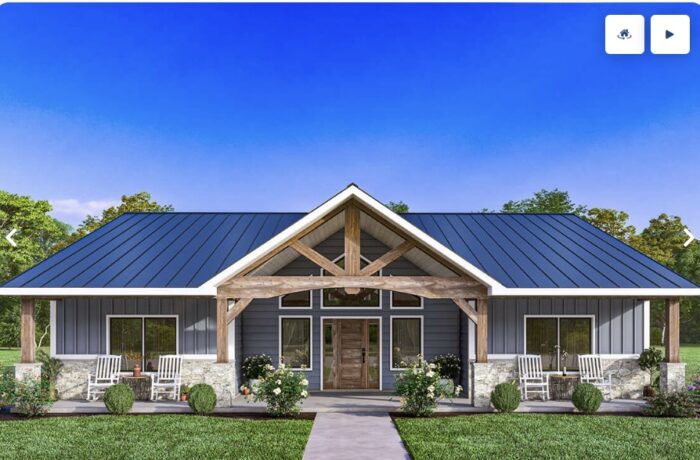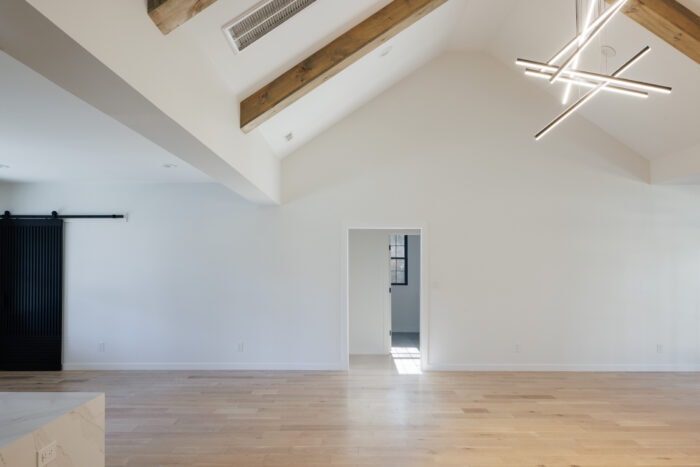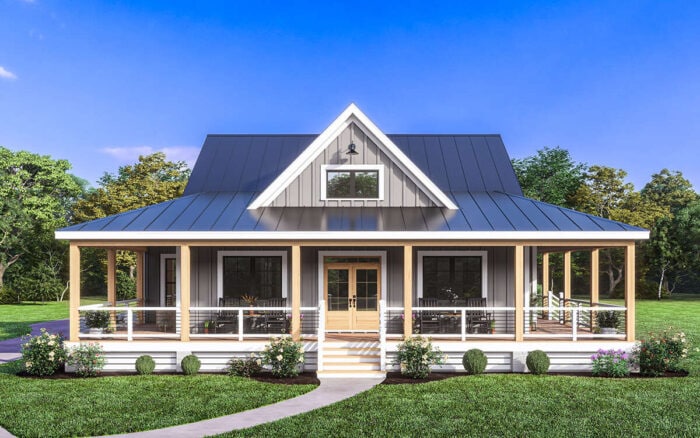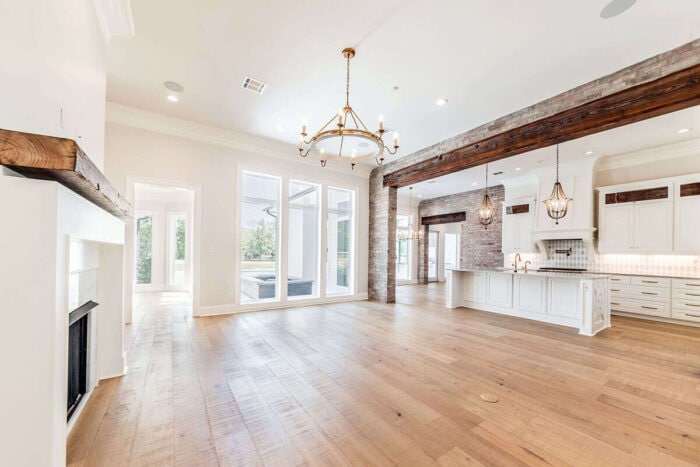- Shop
- Styles
- Collections
- Garage Plans
- Services
-
Services
- Cost To Build
- Modifications
- PRO Services
- Contact Us
- Learn
-
Collections
- New Plans
- Open Floor Plans
- Best Selling
- Exclusive Designs
- Basement
- In-Law Suites
- Accessory Dwelling Units
- Plans With Videos
- Plans With Photos
- Plans With 360 Virtual Tours
- Plans With Interior Images
- One Story House Plans
- Two Story House Plans
- See More Collections
-
Plans By Square Foot
- 1000 Sq. Ft. and under
- 1001-1500 Sq. Ft.
- 1501-2000 Sq. Ft.
- 2001-2500 Sq. Ft.
- 2501-3000 Sq. Ft.
- 3001-3500 Sq. Ft.
- 3501-4000 Sq. Ft.
- 4001-5000 Sq. Ft.
- 5001 Sq. Ft. and up
-
Recreation Plans
- Pool Houses
- Sheds
- Gazebos
- Workshops
-
Services
- Cost To Build
- Modifications
- PRO Services
- Contact Us
The Modern Tudor House is an Evolution of Elegance
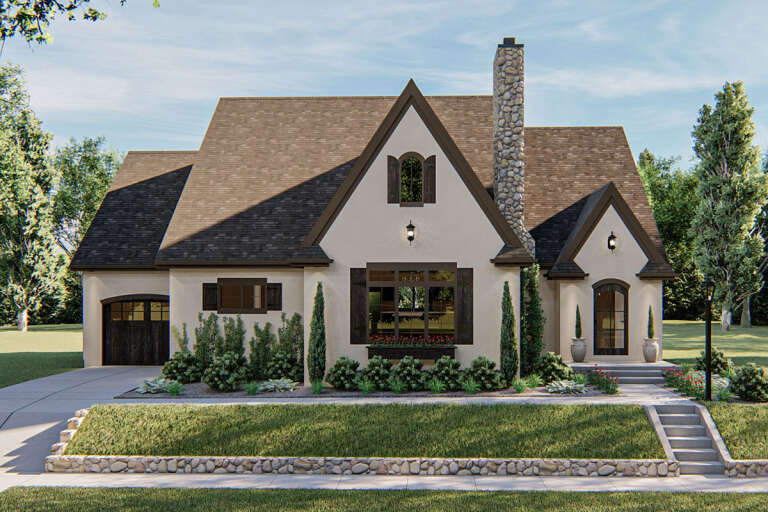
If Modern home architecture feels too full of hard edges, right angles, and cold steel for your personal design aesthetic, let us introduce you to the romance and charm of the Modern Tudor House! That’s right, the home design that dates back centuries never disappeared. It’s seen a resurgence, and it’s better than ever.
Tudor house architecture, originating during the Tudor period in England, is characterized by its distinct half-timbered framing, steeply pitched roofs, cross gables, and tall, narrow windows. Rich in historical charm and European elegance, these homes were traditionally constructed with a timber frame filled with wattle and daub or brick.
In its Modern form, the Tudor style retains its iconic architectural features while integrating contemporary materials and amenities. Today’s Modern Tudor homes meld the timeless allure of the past with the functional needs of the present, embodying a sophisticated blend of old-world charm and Modern elegance.
The Essence of Classic Tudor Architecture
To best understand the elegance of a Modern Tudor-style house, it’s best to learn more about its predecessor. During the 16th century, the Tudor home was symbolic of the architectural Renaissance in England, with quite a few distinguishing features setting it apart from other styles of homes:
- Half-Timbering: Perhaps the most recognizable hallmark, half-timbered homes showcased a wooden framework with spaces filled with wattle and daub or brick. This technique was not only structural but became a prominent decorative feature.
- Steeply-Pitched Roofs: Tudor homes boasted steeply-pitched, multi-gabled roofs, often clad in thatch or clay tiles. The pronounced angle helped to quickly shed rain in the often-damp English climate.
- Tall, Narrow Windows: Arranged in a symmetrical pattern, these windows were typically made of small, diamond-shaped panes held together by lead strips, known as lattice windows.
- Prominent Chimneys: Brick chimneys, often ornately decorated, were a significant feature, reflecting the importance of fireplaces in multiple rooms for heating.
- Jettied Upper Floors: The upper stories of Tudor homes often overhung the floor below, a feature known as jettying. This design increased living space on the upper floors without extending the building’s foundation.
- Inner Courtyards: Larger Tudor homes commonly feature enclosed courtyards, offering both privacy and protection from the elements.
- Ornate Doorways: Doorways were often elaborately carved and surrounded by decorative stonework or timber, signifying the home’s entrance as a point of prestige.
Together, these hallmarks of 16th-century Tudor architecture painted a vivid picture of a period marrying both form and function, creating homes that were as aesthetically striking as they were structurally sound and paved the way for the Modern Tudor house style we see today.
The Evolution of Design: What Makes a Modern Tudor House
While still embodying the timeless charm of its historical counterpart with features like half-timbering and steeply pitched roofs, modern Tudor house plans introduce an array of 21st-century modifications. Embracing current building materials, such as engineered wood or modern stucco, these homes often incorporate open floor plans that cater to today’s lifestyle preferences.
While the tall, narrow windows of yesteryears remain a signature element, they now benefit from energy-efficient glazing and broader design variations. Furthermore, today’s contemporary Tudor homes often showcase luxurious modern amenities, including state-of-the-art kitchens, spa-inspired bathrooms, and advanced home automation systems.
Adapting to Contemporary Aesthetics
Modern Tudor homes have gracefully evolved to meld with contemporary design aesthetics, striking a balance between their historical roots and the demands of today’s homeowners. Here’s how they’ve adapted:
- Updated Kitchen and Bathrooms: These spaces now gleam with state-of-the-art appliances, fixtures, and fittings. The juxtaposition of modern amenities with Tudor-inspired elements like exposed beams or lattice windows creates a rich visual and functional tapestry.
- Blended Landscapes: Modern Tudor-style house plans often feature outdoor spaces that seamlessly combine English garden aesthetics with Modern landscaping techniques, incorporating elements like outdoor kitchens or fire pits.
- Versatility in Scale: Modern Tudors aren’t confined to sprawling estates anymore; their design elements have been adeptly scaled to fit urban townhouses or suburban homes, demonstrating the style’s adaptability.
- Hybrid Design: In addition to scale, there’s a blending of Tudor features with other architectural styles, resulting in homes that carry the “essence” of Tudor design but also incorporate features from styles such as Modern, Craftsman, or Colonial.
Integrating 21st-Century Technology and Sustainability
The Modern Tudor house, marrying a time-honored architectural style with the demands of the 21st century, can seamlessly integrate advanced technology and sustainability principles without sacrificing the charm and elegance of the design. Here are just a few examples of how owners have brought the past into the present:
- Energy-Efficient Glazing: Traditional lattice windows have been upgraded with double or triple glazing, reducing heat loss, enhancing insulation, and cutting down on energy bills.
- Smart Home Integration: These homes often come equipped with advanced home automation systems, allowing homeowners to control everything from lighting and heating to security, all from their smartphones or voice-activated devices.
- Solar Integration: Discreet solar panels can be incorporated into the roofing, enabling homes to harness renewable energy. Some designs might also utilize solar tiles, which blend more seamlessly with traditional roofing materials.
- Green Insulation: Beyond the aesthetic, modern Tudors can use eco-friendly insulation materials, like sheep’s wool or recycled cellulose, improving energy efficiency while staying true to the sustainable ethos.
- LED Lighting: While maintaining ambient and period-appropriate lighting designs, modern Tudor houses often utilize LED lights, which are both energy-efficient and long-lasting.
- Advanced Ventilation Systems: Ensuring fresh indoor air, advanced HVAC systems equipped with smart thermostats and air purifiers can be integrated, promoting health and efficiency.
- Low-flow Plumbing: Bathrooms and kitchens, while echoing Tudor aesthetics, often have water-saving fixtures, reducing water consumption without compromising on functionality.
Essential Components of a Modern Tudor House
Now knowing what’s been changed and added to enhance the appeal of Tudor homes to the contemporary home buyer, it’s interesting to note how modern-day technology and trends are helping maintain the beauty and charm of modern Tudors, but with a twist.
Use of Modern Materials in Tudor Designs
Modern Tudor house plans, while drawing inspiration from their historic counterparts, employ a range of contemporary materials to meet today’s building standards and aesthetic demands. Here are some of the prevalent modern materials used in their construction:
- Engineered Wood: This material provides the traditional look of timber framing but with increased durability and resistance to warping, rotting, and pests. It’s often used for beams, facades, and interior elements.
- Fiber Cement Siding: Mimicking the look of wooden boards or stucco, fiber cement siding offers durability, fire resistance, and low maintenance – making it a popular choice for modern Tudor exteriors.
- Vinyl or Aluminum Windows: While maintaining the classic tall, narrow appearance of Tudor windows, these materials offer enhanced insulation and longevity and require minimal upkeep.
- Modern Stucco: A more durable and weather-resistant version of the traditional material, modern stucco is often used to fill the spaces between timber frames, providing a smooth or textured finish.
- Brick Veneer: Giving the look of solid brick without the associated thickness and weight, brick veneer is a popular choice for both exteriors and interior accents in modern Tudor houses.
- Composite Roofing: Imitating the look of traditional clay tiles or wooden shingles, composite roofing materials are lightweight, durable, and can offer better insulation.
- Steel Beams and Joists: Used in the structural framework, especially for larger homes or open layouts, steel provides the necessary support without the bulk of traditional materials.
- Synthetic Stone: Offering the elegance and texture of natural stone without the weight and at a fraction of the cost, synthetic stone can be used for facades, fireplaces, and interior accents.
Incorporating these materials, modern Tudor homes achieve a harmonious blend: they resonate with the style’s historical essence while ensuring durability, energy efficiency, and modern-day practicality (as well as being up to modern code compliance).
Open Floor Plans: Merging History with Modern Needs
Open floor plans have become a defining feature of modern architectural design, and their integration into modern Tudor houses exemplifies a masterful confluence of history with today’s lifestyle demands. Here’s how these layouts facilitate this elegant merging:
- Spatial fluidity and functionality: Traditional Tudor homes, characterized by distinct, separate rooms, have given way to expansive, interconnected spaces in modern interpretations. This shift not only meets the contemporary preference for spaciousness but also offers versatility in function—a dining area might seamlessly flow into a living space or an open kitchen.
- Natural light amplification: One of the challenges with older Tudor homes was dim interiors due to compartmentalized spaces. Open floor plans allow sunlight from the tall, narrow Tudor windows to permeate more deeply and uniformly, enhancing the warmth and brightness of the interiors.
- Preservation with adaptation: While the skeletal structure and external aesthetics of a modern Tudor-style house resonate with history, the interior layout’s openness speaks to the modern era. This duality ensures that while the historical charm is preserved, the home remains functionally relevant.
- Flexible design opportunities: An open layout allows homeowners and designers to experiment with interior design elements, integrating Tudor-inspired features like exposed beams or brickwork and contemporary decor seamlessly.
Tudor-style Landscaping and Outdoor Elements
The outdoor spaces and landscaping of Tudor homes have experienced a significant evolution, parallel to the changes seen in the homes themselves. While they draw inspiration from their historical roots, modern Tudor-style landscaping and outdoor elements have been adapted to cater to contemporary lifestyles and aesthetics. Here’s how they’ve transformed:
- Functional Gardens: The intricate and decorative gardens of historic Tudor homes, with their parterres and knot gardens, have given way to more functional spaces in modern iterations. Vegetable patches, herb gardens, and fruit-bearing trees are now common, reflecting a growing desire for organic and home-grown produce.
- Integration of Outdoor Living Spaces: Modern Tudor house plans frequently feature patios, decks, and outdoor kitchens, emphasizing a seamless indoor-outdoor living experience. These spaces are often adorned with contemporary amenities like fire pits, built-in grills, and plush seating.
- Simplified Hedges and Borders: Instead of the intricate hedge mazes or heavily bordered gardens of yore, modern Tudor landscapes favor streamlined, clean-cut hedges and borders, aligning with contemporary minimalistic aesthetics.
- Automated Irrigation: Modern Tudor gardens frequently utilize automated and drip irrigation systems, ensuring optimal water usage and plant health.
- Integrated Recreational Spaces: Reflecting today’s active lifestyles, it’s not uncommon to find tennis courts, swimming pools, or even mini-golf areas integrated into the landscapes of expansive modern Tudor estates.
In marrying the storied elegance of Tudor design with today’s preferences and technologies, modern Tudor-style landscaping and outdoor elements stand as a testament to architectural and design evolution, skillfully intertwining the past’s charm with the present’s innovations.
The Modern Tudor house is more than just a revival of a bygone architectural era; it is a resounding testament to the enduring appeal of a style that has gracefully weathered centuries. By masterfully blending the iconic elements of traditional Tudor architecture with today’s materials, technologies, and design sensibilities, these homes represent the pinnacle of evolution in home design.
They harmoniously bridge the historical with the contemporary, proving that it’s possible to pay homage to the past while catering to the functional and aesthetic demands of the present. For homeowners and enthusiasts alike, the modern Tudor house isn’t just a dwelling; it’s a living, breathing emblem of timeless elegance seamlessly woven with 21st-century sophistication.

Brandon Hall
Our "go to guy" and company expert, Brandon is the visionary and dreamer of all we do here at America's Best House Plans. He manages quality assurance, audits existing processes for maximum effectiveness, and develops strategies to increase productivity and efficiency. With over 15 years experience in the home design industry, Brandon has a hand in every aspect of the day-to-day operations of our company, in addition to ensuring an unparalleled level of service to our customers.
Related Articles
April 4, 2024
/Brandon Hall
How to Choose a House Plan
The options are nearly endless. Stock house plans are filled with possibilities, individua …

March 29, 2024
/Brandon C Hall
Featured Style: Mountain and Mountain Rustic House Plans
Whether you’re searching for the perfect house plan to utilize as a vacation property or for a pri …

March 21, 2024
/Brandon C Hall
Why Choose a House Plan with a Mudroom?
Sometimes, it really is the little things that make a house a home. When choosing the right house pl …

March 12, 2024
/Brandon Hall
Featured House Plan Style: Modern
Are you looking to build a beautiful home with an open, minimalist bent on design? What are your val …

March 3, 2024
/Brandon C Hall
Find Your Perfect Vacation House Plan
Have you set your sights on having a vacation home in the near future? Owning a simple, peaceful vac …

February 25, 2024
/Brandon C Hall
House Plans with Videos
You requested, and we listened! We understand that it can be difficult to visualize how a finished h …

February 18, 2024
/Brandon C Hall
Types of Flooring: Choosing the Best Option for Your Home
Your choice of flooring sets the foundation for the overall ambiance and functionality of your livin …

February 9, 2024
/Brandon C Hall
How to Calculate Roof Pitch
Whether you’re a seasoned DIY enthusiast or a first-time homeowner with a curious mind, unders …

February 3, 2024
/Brandon C Hall
Why the Open Concept Kitchen Is So Popular
The convenience and comfort of an open-concept kitchen are heavily sought after in the modern house …

HOUSE PLANS
SERVICES
Enter your email to receive exclusive content straight to your inbox



